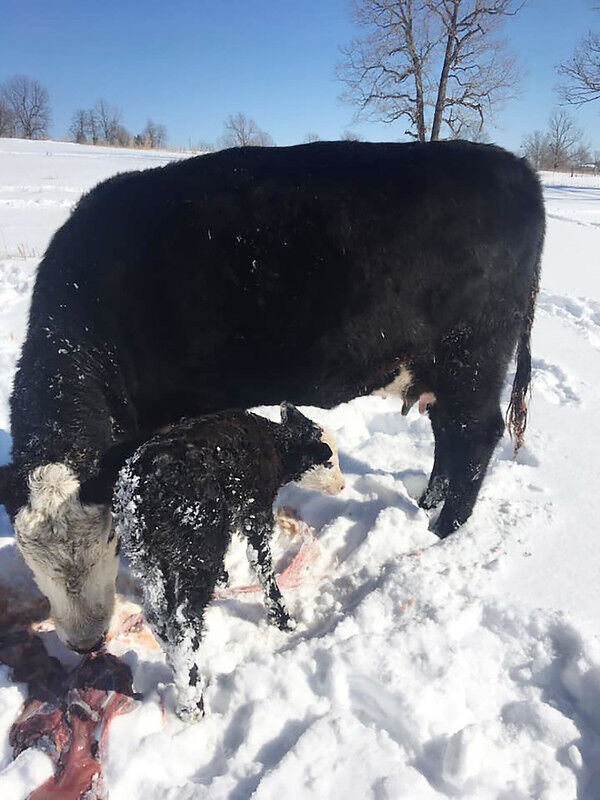Snow collapses poultry houses in Lincoln County, ranchers lose calves to deep freeze

A week of rising temperatures will give those in Arkansas agriculture a window to assess damage and losses caused by a week of record cold and snowfall.
The National Weather Service at Little Rock said snowfall totals for Feb. 14 to 18 ranged from 6 inches to more than 22 inches. The heaviest snow fell in a band from Texarkana to just east of Stuttgart. Temperatures dropped into single digits and below zero in many parts of the state, with Fayetteville seeing a reading of minus 20 degrees Fahrenheit.
High temperatures for the week of Feb. 21 were expected to rise to nearly 60 degrees in some parts of the state.
Matthew Davis, Jackson County extension staff chair for the University of Arkansas System Division, said the effects of the deep freeze will be felt across multiple aspects of agriculture.
“The next week or so will be a time of assessment; seeing what needs to be done for everyone,” he said.
“Wet and muddy conditions appear to be sticking around for some time,” he said. “Even with snow melting we have rain in the forecast, so any row crop work will be delayed into the first of March looking at the extended forecast.”
Heavy snow caused disruptions along interstates in Arkansas and stopped traffic along many rural routes, bringing supply runs to a halt.
“Trucks are several days behind now causing essential items to be in short supply for both humans and animals,” said Davis.
Farmers to the rescue
Amy Greenwalt Tallent, Prairie County extension agent, and her family saw this firsthand.
“Due to the pile-up on I-40, which was at a standstill for about 12 hours, and which runs through our farm, truck drivers were looking for alternate routes. Their trusty GPS took them on Highway 249,” she said.
Arkansas 249 route runs between I-40 and U.S. 70 via several 90 degree turns and happens to run through their family farm.
“Two 18-wheelers were stuck overnight on these roads,” Tallent said. “My dad, Eric Greenwalt, was making his morning circle (through the farm) and came upon them. So, he and my husband, Chad Tallent, along with a county deputy, pulled them to U.S. 70 with a tractor so they could be on their way.
“If they would have had to wait on a wrecker to pull them out it would have been late last night because of the need for them on the interstate,” she said. “We tend to have to do this during any snow event that stops the interstate, but we are always glad to help out!”
Real losses
The heavy snow that came with a second round of winter weather proved too much for some poultry houses in southeastern Arkansas.
Lincoln County extension staff chair Steve Stone said the snow crushed the roofs of several poultry houses in his county. The website searkweather.com also reported the Cornerville Fire Department being called to a poultry house that collapsed and caught fire on Wednesday.
Lincoln County saw between 12 and 14 inches of snow, Stone said.
Sign up for HPJ Insights
Our weekly newsletter delivers the latest news straight to your inbox including breaking news, our exclusive columns and much more.
“There are over 30 poultry houses with some amount of damage,” Stone said. “One farm had five of eight houses collapsed and another that may not make it through the night.”
Challenges in cattle country
Poultry growers weren’t alone. In Clark County, snow collapsed a wooden barn, county extension agent Amy Simpson said.
“Like all other producers, the struggle to keep water thawed was a huge issue,” said Cory Tyler, Fulton County’s agriculture extension agent. “Even ‘freeze proof’ options were still freezing, adding to the producers’ already-full workload.”
Simpson said it was so cold that “the net wrap on the hay bales froze and has been very difficult to remove.”
Tyler said adding to the difficulty of making sure the livestock were fed and had water, was that many producers “were dealing with livestock giving birth—this included both cattle and goats. Due to the extreme cold and snow, producers who knew livestock were in the final stages of gestation were continually checking their herds multiple times during the day and night.”
While cattle and other livestock can adapt to snowy conditions, the sudden nature of the change was problematic.
“Since the temperatures dropped so fast, they didn’t have time to adapt, and therefore it was much harder on livestock than normal,” Tyler said.
“Producers checked livestock constantly, compared to other times of the year, so that if intervention was needed, it could be done quickly,” he said. “This normally resulted in a calf in the floorboard of a pickup truck or tractor or in the producer’s house in front of the propane stove.”
Sherry Beaty-Sullivan, Polk County extension staff chair for the Division of Agriculture, suffered losses at her cattle operation.
“We personally have lost eight calves” to cold temperatures, she said. “Like many ranchers in Polk County, we are just trying to stay ahead by supplying extra feed and breaking ice. We have two hired hands to help or there is no way we could do that keep an eye on heifers’ calves.”
